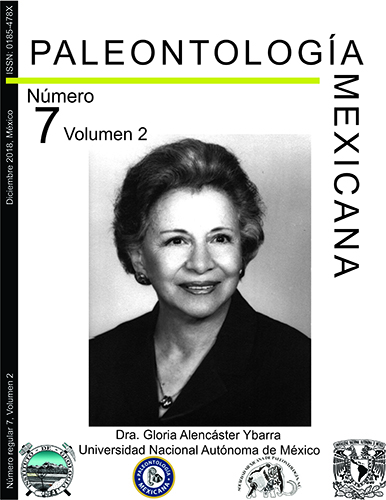Taxonomic description of Camelops hesternus, from La Muela stream, Baja California Sur, Mexico
Main Article Content
Abstract
In this work, skeletal remains of a fossil Camel from arroyo La Muela, Baja California Sur, México are described. Based on its dental formula and meristic data, the specimen is assigned to Camelopshesternus, a widely distributed species in North America during the Pleistocene. Furthermore, comparisons to the fossil described by Webb (1965) at La Brea Tar Pits (California) do not show significant morphological differences with ours, suggesting that the geographic distribution of Camelops hesternus included the southern part of the Baja California peninsula.
Article Details

This work is licensed under a Creative Commons Attribution-NonCommercial-NoDerivatives 4.0 International License.
References
Baskin, J., Thomas, R., 2016, A review of Camelops (Mammalia, Artiodactyla, Camelidae), a giant llama from the Middle and Late Pleistocene (Irvingtonian and Rancholabrean) of North America: Historical Biology, 28(1–2), 120–127.
Bell, C.J., Lundelius Jr., E.L., Barnosky, A.D., Graham, R.W., Lindsay, E.H., Ruez Jr., D.R., Semken Jr., H.A., Webb, S.D., Zakrzewski, R.J., 2004, The Blancan, Irvingtonian, and Rancholabrean mammal ages, en Woodburne, M.O. (ed.), Late Cretaceous and Cenozoic Mammals of North America: New York, Columbia University Press, 232–314.
Ceballos, G., Arroyo-Cabrales, J., Ponce, E., 2010, Effects of Pleistocene environmental changes on the distribution and community structure of the mammalian fauna of Mexico: Quaternary Research, 73, 464–473.
Dalquest, W., 1992, Problems in the nomenclature of North American Pleistocene camelids: Annales Zoologici Fennici, 28, 291–299.
Ferrusquía-Villafranca, I., Torres Roldán, V., 1980, El registro de mamíferos terrestres del Mesozoico y Cenozoico de Baja California: Revista del Instituto de Geología, 4(1), 56–62.
Ferrusquía-Villafranca, I., Arroyo-Cabrales, J., Martínez-Hernández, E., Gama-Castro, J., Ruiz-González, J., Polaco, O.J., Johnson, E., 2010, Pleistocene mammals of Mexico: A critical review of regional chronofaunas, climate change response and biogeographic provinciality: Quaternary International, 217, 53–104.
Harrison, J., 1985, Giant Camels from the Cenozoic of North America, Smithsonian Contributions to Paleobiology: Smithsonian Institution Press, 57, 1–33.
Heintzman, P.D., Zazula, G.D., Cahill, J.A., Reyes, A.V., MacPhee, R., Shapiro, B., 2015, Genomic data from extinct North American revise camel evolutionary history: Molecular Biology and Evolution, 32(9), 2433–2440.
Honey, J.G., Harrison, J.A., Prothero, D.R., Stevens, M.S., 1998, Camelidae, en Janis, C.M., Scott, K.M., Jacobs, L.L. (eds.), Evolution of Tertiary mammals of North America, vol. 1: terrestrial carnivores, ungulates, and ungulatelike mammals: Cambridge, Cambridge University Press, 439–462.
Jiménez-Hidalgo, E., Carranza-Castañeda, O., 2010, Blancan camelids from San Miguel de Allende, Guanajuato, Central México: Journal of Paleontology, 84(1), 51–65.
Kurten, B., Anderson, E., 1980, Pleistocene Mammals of North America: New York, Columbia University Press, 442 pp.
Leidy, J., 1854, Description of a Fossil Apparently Indicating an Extinct Species of the Camel Tribe: Proceedings of the Academy of Natural Sciences of Philadelphia, 68, 172–173.
Rochín-Bañaga, H., Schwennicke, T., Herrera-Gil, L.H., 2017, Registro de Mammuthus columbi en el área de El Carrizal, Baja California Sur, México: Boletín de la Sociedad Geológica Mexicana, 69(2), 495–503.
Scherer, C.S., 2013, The Camelidae (Mammalia, Artiodactyla) from the quaternary of South America: cladistic and biogeographic hypotheses: Journal of Mammalian Evolution, 20, 45–56.
Thompson, M.E., White, R.S.J., 2004, Getting over the hump: Blancan records of Camelops from North America, with special reference to Hagerman, Idaho and the 111 Ranch, Arizona. Denver, Colorado: Geological Society of America. Abstracts with Programs, 36, 54.
Waters, M.R., Stafford, T.W., Kooyman, B., Hills, L.V., 2015, Late Pleistocene horse and camel hunting at the southern margin of the ice-free corridor: reassessing the age of Wally’s Beach, Canada: Proceedings of the National Academy of Natural Sciences of the United States of America, 112, 4263–4267.
Webb, S.D., 1965, The osteology of Camelops: Bulletin of the Los Angeles County Museum, 1, 1–54.
Zazula, G.D., Turner, D.G., Ward, B.C., Bond, J., 2011, Last interglacial western camel (Camelops hesternus) from eastern Beringia: Quaternary Science Reviews, 30, 2355–2360.
Zazula, G.D., Macphee, R.D.E., Hall, E., Hewitson, S., 2016, Osteological Assessment of Pleistocene Camelops hesternus (Camelidae: Camelinae: Camelini) from Alaska and Yukon: American Museum Novitates, 3866, 1–45.
